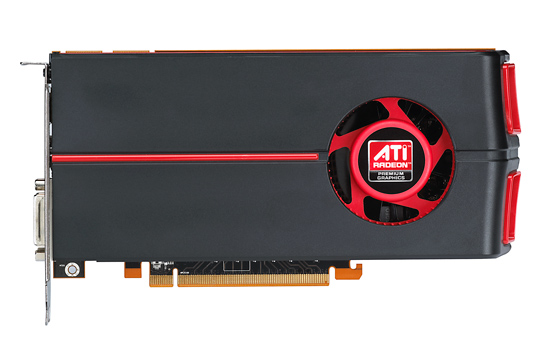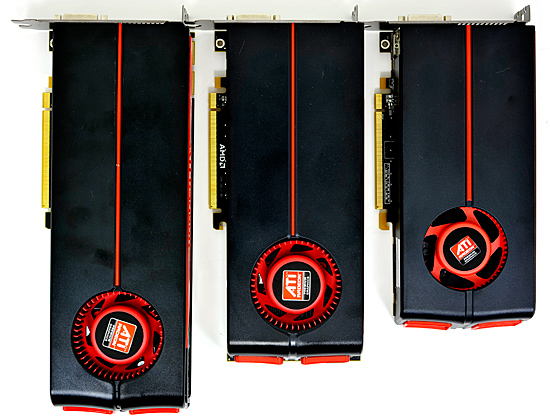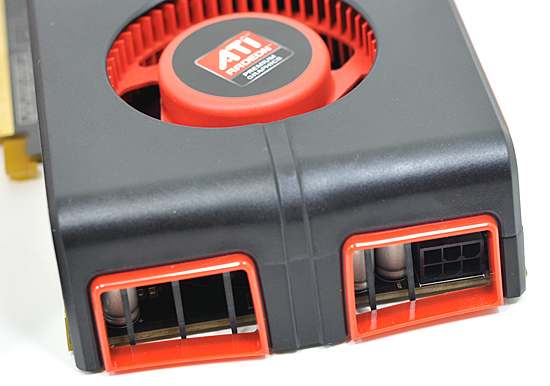AMD’s Radeon HD 5770 & 5750: DirectX 11 for the Mainstream Crowd
by Ryan Smith on October 13, 2009 12:00 AM EST- Posted in
- GPUs
Meet The 5770
We’ll start our look at today’s cards with the 5770. As we mentioned previously the 5770 is the full speed Juniper card, with all 10 SIMDs enabled, and clocked at 850MHz for the core and 1.2Ghz (4.8GHz data rate) GDDR5 for the RAM. As has become the current standard for just about every card over $100 these days, the card is equipped with 1GB of RAM. Attaching this RAM to the GPU is a 128-bit bus, giving the card 76.8GB/sec of memory bandwidth. The use of such fast RAM strikes our interest in particular, since it means vendors are spending just as much to equip a 5770 with RAM as they are a 5870.

For cooling, the 5770 uses the same general plastic shroud as the 5800 series cards, which AMD’s 5700 team told us is called the Phoenix. Here the shroud hangs over the rear of the card by just less than half an inch, making it more like the 5870 than the 5850 where the shroud stopped at the edge of the card. The length of the card is 8.25”, adding the shroud brings it to just shy of 8.75”.

5870, 5850, 5770
Interestingly enough, we’ve been told that the Phoenix shroud isn’t going to be sticking around for long. The first wave of cards launching today and for the near future will be using the shroud, but once AMD’s vendors begin using their own designs, AMD doesn’t expect most of the vendors to stick with the shroud. XFX has specifically been named as a party that will keep using the shroud on products, but anyone else is subject to change. With a TDP of only 108W, the Phoenix shroud is probably overbuilt and certainly more expensive than vendors would like, where mainstream products come with thinner margins. We would expect the vendors that do switch to move to more traditional dual-slot coolers, likely ones that aren’t shrouded at all and would not blow hot air outside of the case.
While we were fine with the shroud on the 5800 series, we do take slight issue with it on the 5770. Because the single 6-pin PCIe power connector on this card is on the rear of the card, the shroud is in the way of the PCIe power connector. This wasn’t an issue on the 5870 since the power connectors were on top, and on the 5850 the shroud stopped at the end of the card. But here the extra shroud makes it much harder to see what you’re doing when it comes to plugging in a PCIe power connector unless you’re looking at the rear of the card, and it makes it a bit harder to remove a PCIe power plug once placed.

AMD made it clear to us that they did consider this in the design of the 5770, and to their credit the shroud never makes inserting/removing a PCIe power plug impossible, but that doesn’t mean we have to like it. We would have liked to see the shroud go the same length as the card, so that it would be just as easy to use as the 5850.
At any rate, along with keeping the 5800 series shroud, the 5770 keeps the port configuration. 1 DisplayPort, 1 HDMI port, and 2 DVI ports make up the card’s output options. This is intentional on the part of AMD, as they want to push Eyefinity on these cards just as much as they do on their high-end products, which means they want to use the same ideal configuration. We wouldn’t be shocked to see this modified at the same time as vendors dropping the shroud though; 1 DVI, 1 HDMI, and 1 DisplayPort with a flexible HDMI->DVI adapter is a likely configuration.

The price of DisplayPort->DVI dongles rears its head once again here, and even more severely. DisplayPort monitors are still rare, so the most likely Eyefinity configuration is going to be 3x DVI, which is going to require a dongle. Those dongles are still going for $100+ right now, which is a significant fraction of the price of the card itself. We talked to AMD about this issue, but it’s something that’s out of their hands for the moment.
AMD is pricing this card at $159. This puts it in competition with the cheapest GTX 260s from NVIDIA, and AMD’s 4870, the latter of which tends to sell for only $10 less for the 1GB version. AMD wouldn’t give us a clear idea on how long they expect the 4870 to last, but it seems clear that they intend to phase out the 4870 with the 5770. This may not be such a great idea, but we’ll get to that after we take a look at performance.
Notably, this leaves a $100 pricing hole in AMD’s 5000-series product lineup, since the next card up is the $259 5850. AMD pointed out to us that this is by no means unprecedented (the 4800 series launch saw a $100 gap between the 4870 and 4850) but we’re not used to seeing such a gap in recent times. This price gap makes a little more sense with AMD’s target demographics: the 5800 series is for 2560x1600 gaming, while the 5770 is targeted for 1920x1200/1080. So as far as they’re concerned, there isn’t a demographic gap to make the price gap a problem.
Anyhow, for the time being, the 4890 will function as a slight bridge on that pricing gap. It will continue to occupy a range around $180-$200.
For today’s launch, availability is expected to be in the “tens of thousands” of units. We suspect that the situation is going to mirror the 5870 launch (tight availability at first) but we’ll see. For this launch period, AMD is also extending the DIRT 2 freebie offer to vendors that want to include it with their 5770 cards. So most if not all cards will come with a voucher for this game to get it in December.










117 Comments
View All Comments
hsoverma - Tuesday, October 13, 2009 - link
I bought a 3870 for about 210.00 a year and a half ago. This card has double the performance, a lot more features, and is starting at 160.00. I figure by christmas, it will be down around 120.00. I run a small frag-box, so the lower heat and lower power makes sense for me over a 4870, and if I ever wanted more power, I could run two of these in crossfire and have all that I need. I am putting this card on my wish-list. Thanks again for a great review.7Enigma - Tuesday, October 13, 2009 - link
Great article except for the flaw of not a single Memory OC data point. If as the data shows the 5770 is performing poorly due to inadequate memory bandwidth (seemingly the ONLY issue hampering performance when comparing specs between it and the 4870), it makes sense that a simple OC could shed some light on this issue. Please update the article with some numbers as this card is mainstream enough that I would imagine overclockers *could* see this as a gem in disguise.Ryan Smith - Tuesday, October 13, 2009 - link
Once things calm down, we're going to do a 5800 series overclocking article. It's something that takes a while to put together, and there are major product launches every week right up through the end of this month.7Enigma - Wednesday, October 14, 2009 - link
Can you give us a hint then whether this memory has the potential to overclock well enough to where the bottleneck is overcome? I doubt it can completely remedy the situation but if the memory overclock was enough to make up for the significantly narrower bus in most cases, I think this card would have a better reception.Etern205 - Tuesday, October 13, 2009 - link
Just a stupid question...ATi's Eyefinity requires a display port monitor to work properly (saw on youtube video), and what it does is makes the image share across the screen.
My question is can you use the ATi card and use all monitors independently without the eyefinity feature?
squeezee - Tuesday, October 13, 2009 - link
Yes, you can run the displays independantly just as with any other card. However the 3rd monitor always needs to be Displayport. (or use an ACTIVE displayport adapter)EJ257 - Tuesday, October 13, 2009 - link
I'm sure there is a perfectly good explanation for this that I'm missing. You say there is 1 SIMD disabled in the 5750 vs the 5770. Looking at the chart on the first page there is a difference of 80 stream processors and 4 texture units between the 5750 & 5770 so this would indicate 4 SIMDs are disabled.EJ257 - Tuesday, October 13, 2009 - link
Wait, never mind. I see each SIMD consists of 4 texture units and 20 SP (Stream Processors) and each SP contains 4 Stream Cores. I guess in the chart when you say Stream Processors you really mean Stream Cores right?yacoub - Tuesday, October 13, 2009 - link
Ryan - THANK YOU for including the 8800GT in the graphs: That is the card I (and many other potential buyers) will be upgrading from, moving to a DX11 card.It's too bad this new card (5770) can't quite catch the GTX260 C216, as that is its main NVidia competitor in performance and price. It uses just as much Load wattage as a 260, but seems to offer around 80-90% of the performance. Perhaps if they hadn't cut the bandwidth to 128-bit, it would have squashed the GTX-260. But ATI has a habit of under-bussing their cards and it continues to negatively impact high resolution performance, no matter what certain reviewers might claim about the bus-width not hurting performance. Time and again, testing shows potential for improvement from a wider bus.
Blah. ATI, you always come so close to getting me to purchase but there's always something to hold me back. Perhaps if/when this card drops to $139 (without rebates). But by then NVidia might have their answer out and the GTX-260 would also drop in price or be replaced with a DX11 part, and then the 5770 again loses appeal.
MadMan007 - Tuesday, October 13, 2009 - link
I think you'll pass out if you try to hold your breath waiting for a lower midrange NV DX11 answer to these cards.